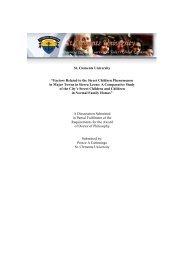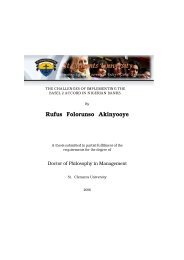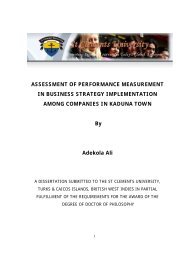The role of informal microfinance institutions in saving
The role of informal microfinance institutions in saving
The role of informal microfinance institutions in saving
You also want an ePaper? Increase the reach of your titles
YUMPU automatically turns print PDFs into web optimized ePapers that Google loves.
oth governance and economic activities, which could generate <strong>in</strong>comes for the vast majority,<br />
and thus enhance sav<strong>in</strong>gs and <strong>in</strong>vestment. This would accelerate the pace <strong>of</strong> economic<br />
development.<br />
6. <strong>The</strong> importance <strong>of</strong> putt<strong>in</strong>g <strong>in</strong>stitutional framework <strong>in</strong> place to provide avenues for sav<strong>in</strong>gs<br />
and <strong>in</strong>vestment must also be recognized. While formal <strong><strong>in</strong>stitutions</strong> have worked efficiently <strong>in</strong><br />
the developed economics, the outcomes, <strong>in</strong> the develop<strong>in</strong>g countries have been less than<br />
satisfactory. <strong>The</strong> f<strong>in</strong>ancial dualism that characterize most develop<strong>in</strong>g economies and the need<br />
to put the <strong><strong>in</strong>formal</strong> sector <strong>in</strong> proper focus pose serious challenges for sav<strong>in</strong>gs mobilization <strong>in</strong><br />
these economies. Cross-country experiences <strong>in</strong> Africa, Asia and Lat<strong>in</strong> America have shown that<br />
sav<strong>in</strong>gs can be harnessed from the poor given the right <strong>in</strong>stitutional arrangements and efforts<br />
at reach<strong>in</strong>g the population with <strong>in</strong>novative products meet their needs.<br />
2.2.10.5: INSTITUTIONAL PROVIDERS OF MICROFINANCE SERVICES.<br />
<strong>The</strong> pr<strong>in</strong>cipal providers <strong>of</strong> f<strong>in</strong>ancial services to the poor and low-<strong>in</strong>come households <strong>in</strong> the<br />
rural and urban areas <strong>of</strong> Tanzania consist <strong>of</strong> licensed commercial banks, regional and rural unit<br />
banks; sav<strong>in</strong>gs and credit cooperative societies; and several NGOs whose micro-credit delivery<br />
operations are funded and supported with technical assistance by <strong>in</strong>ternational donors.<br />
Regulated and Supervised Institutions providers.<br />
Tanzania has (17) commercial banks, 10 non- f<strong>in</strong>ancial <strong><strong>in</strong>stitutions</strong>, one regional bank and 2<br />
rural unit banks which are subject to licens<strong>in</strong>g, regulation and supervision by the Bank <strong>of</strong><br />
Tanzania under the provisions <strong>of</strong> the Bank <strong>of</strong> Tanzania Act (1995), Bank<strong>in</strong>g and F<strong>in</strong>ancial<br />
Institutions Act (1991), Foreign Exchange Act (1992). <strong>The</strong> licensed and supervised <strong><strong>in</strong>stitutions</strong><br />
are also subject to the regulatory guidel<strong>in</strong>es issued by Bank <strong>of</strong> Tanzania such as the Bank<strong>in</strong>g<br />
and F<strong>in</strong>ancial Institutions Regulations 1997), Bureau de Change Regulations (1996), Foreign<br />
Exchange Regulation (1996), and various guidel<strong>in</strong>es specify<strong>in</strong>g mandatory prudential standards<br />
to be complied with regard<strong>in</strong>g management <strong>of</strong> risk assets, capital adequacy and concentration<br />
<strong>of</strong> credit and exposure limits.<br />
142
















